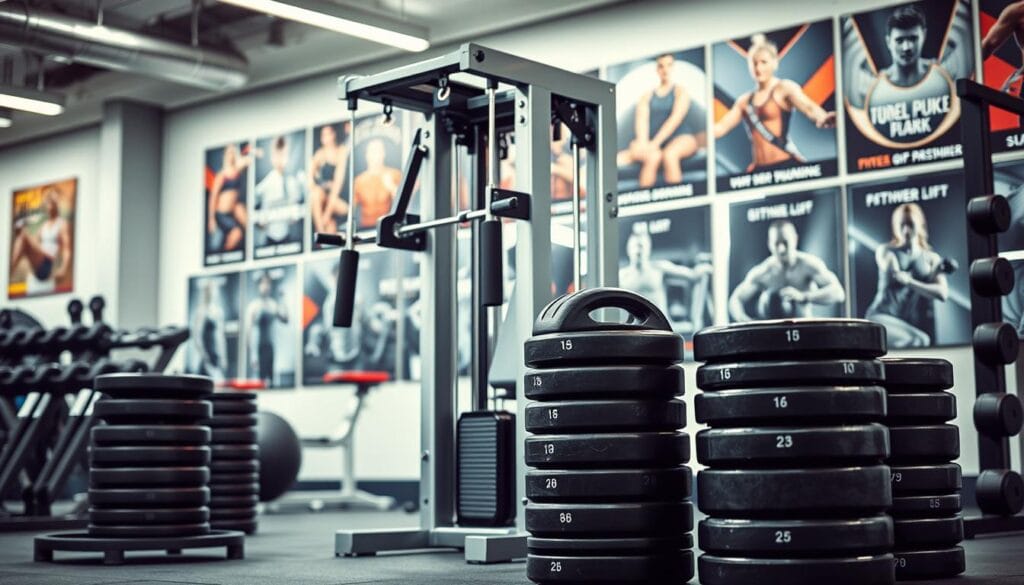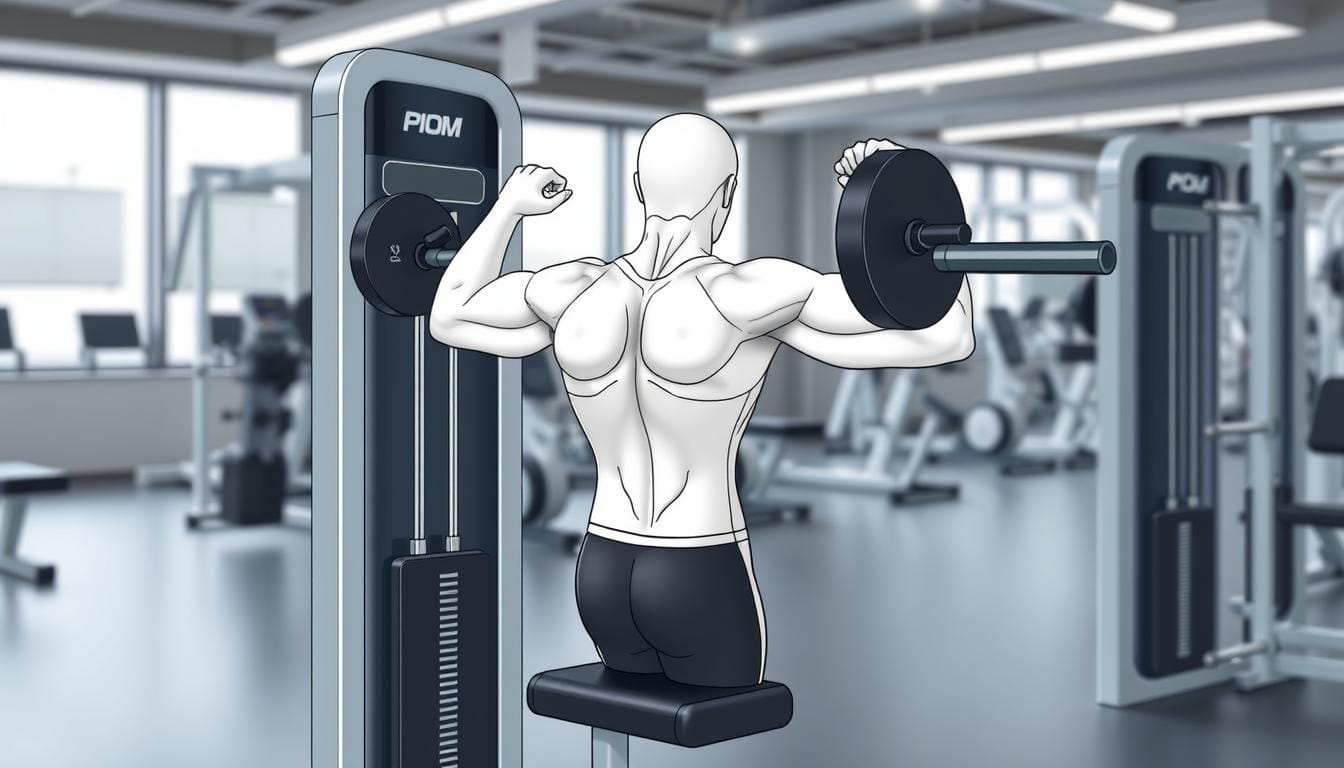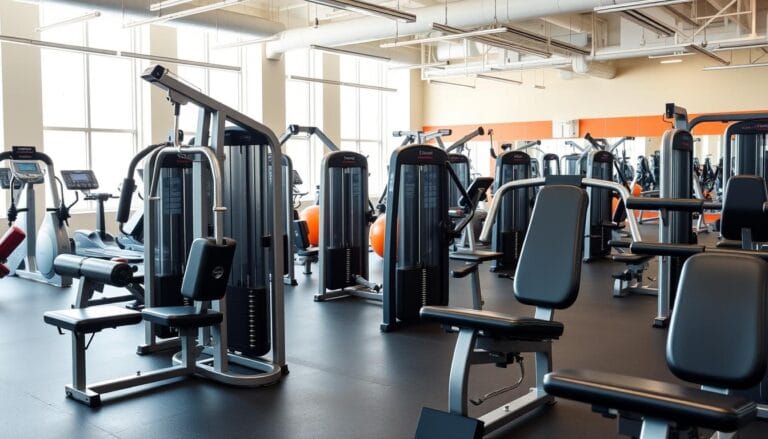How to Use a Shoulder Press Machine for Maximum Gains
Every fitness journey has a moment of transformation. For me, that moment came when I discovered the shoulder press machine. It became my secret weapon for building strength and sculpting impressive shoulders.
If you’ve ever felt stuck in your shoulder training, the shoulder press machine is your breakthrough. It offers a controlled, safe way to develop your shoulders. It’s great for everyone, from beginners to advanced lifters.
The shoulder press machine targets your deltoids with precision. It has recommended rep ranges of 8-12 for muscle growth. You can also choose different training goals. This machine can help you build muscle, increase endurance, or enhance your fitness.
Get ready to unlock the full potential of your shoulder training. Transform your upper body strength with expert techniques and strategies. These will take your fitness to the next level.
Table of Contents
Understanding the Shoulder Press Machine Basics
Shoulder workout machines are key pieces of gym gear. They help build strength and muscle in your shoulders. Knowing how they work can make your workouts better and safer.
The shoulder press machine targets important muscles in a controlled way. Unlike free weights, it has a fixed motion. This reduces injury risks and ensures precise muscle work.
Key Machine Components
It’s important to know the parts of shoulder workout machines for the best results. Here are the main parts:
- Adjustable seat with back support
- Weight stack or plate-loading mechanism
- Handles or grips
- Range-of-motion guides
- Safety stops and pins
Proper Machine Settings and Adjustments
Adjusting gym equipment to fit your body is key for good training. Here’s how to do it:
- Adjust seat height so handles align with shoulder level
- Ensure back is firmly supported
- Position feet flat on the ground
- Select appropriate weight for your fitness level
Safety Features to Check
Always check these important safety features before you start:
| Safety Feature | Purpose |
|---|---|
| Pin Locks | Prevent unexpected weight drops |
| Seat Belt | Stabilize body during exercise |
| Range Limiters | Protect from overextension |
“Proper machine setup is the foundation of a safe and effective shoulder workout.” – Fitness Professionals
Remember, taking time to understand your gym equipment can prevent injuries and maximize muscle development.
Benefits of Using Shoulder Press Machines
Shoulder press machines are great for building strong upper bodies. They help target the shoulder muscles well, making them key for any workout plan.
Here are the main benefits of using shoulder press machines:
- Enhanced Muscle Targeting: The machine precisely targets deltoid muscles with minimal risk of improper form
- Improved Stability: Provides a fixed movement path for safer lifting techniques
- Progressive Overload Potential: Allows systematic muscle growth and strength increases
- Beginner-Friendly Design: Reduces injury risk for new strength trainers
These machines help grow muscles significantly. Studies show users can see up to a 25% increase in muscle mass with regular use.
| Benefit Category | Percentage Improvement |
|---|---|
| Muscle Hypertrophy | 25% |
| Workout Intensity | 20-30% |
| Upper Body Functionality | 15-20% |
| Injury Risk Reduction | 40% |
“The shoulder press machine transforms your workout by providing controlled, effective muscle engagement” – Strength Training Experts
Weight lifting machines, like the shoulder press, are top choices for building shoulder strength. They improve stability and upper body performance. By using these machines, you can make your fitness journey more effective and safe.
Proper Form and Technique Fundamentals
Mastering the shoulder press on a lateral machine is all about precision. It’s important to focus on the details to get the most out of your workout and avoid injuries.
Learning the basics of the shoulder press can really boost your upper body strength. This exercise works on key muscles like the deltoids, trapezius, and triceps.
Starting Position Setup
Getting into the right position is key for a good shoulder press. Here’s how to do it:
- Adjust the seat so your feet are flat on the ground
- Make sure your back is against the machine’s support pad
- Hold the handles with your arms at shoulder width
- Keep your core tight and your spine straight
Movement Execution Guidelines
Doing the shoulder press right is important for muscle growth and safety:
- Begin with the weights at shoulder level
- Press up slowly and in control
- Keep your elbows slightly bent for better tension
- Avoid locking your elbows fully at the top
“Precision in movement trumps weight lifted every time.” – Strength Training Experts
Breathing Pattern During Exercise
Right breathing helps you perform better and stay stable on the lateral machine:
- Breathe in as you lower the weight
- Breathe out when you press the weight up
- Keep your breathing steady
| Technique Aspect | Key Recommendation |
|---|---|
| Grip Width | Shoulder-width, promotes balanced muscle engagement |
| Elbow Position | Slightly bent, prevents joint stress |
| Range of Motion | Full extension without complete lock |
By practicing regularly and focusing on these basics, you can build strong shoulders and stay injury-free.
Common Mistakes to Avoid
Shoulder press machines are great for building muscle. But, many athletes make mistakes that hurt their performance and increase injury risk.
Knowing these common mistakes can help you improve your shoulder workout and avoid setbacks:
- Incorrect Grip Width: Research shows that grip placement outside shoulder width can reduce power output by 5-10%
- Neglecting core engagement, which can decrease stability by up to 20%
- Poor head positioning that restricts range of motion
- Using excessive weight without proper form
Your shoulder is the most mobile joint in the human body. This makes precise technique very important. Bad overhead press technique can cause mobility issues in 30-50% of gym-goers.
“Technique trumps weight every single time in muscle development.” – Professional Strength Coach
Here are some key technical errors to watch for:
| Mistake | Potential Consequence | Correction Strategy |
|---|---|---|
| Arched Back | Lower Back Strain | Maintain Neutral Spine |
| Flaring Elbows | Shoulder Joint Stress | Keep Elbows Aligned |
| Rapid Uncontrolled Movement | Reduced Muscle Engagement | Controlled, Deliberate Pace |
By fixing these common mistakes, you’ll improve your shoulder press technique. This will reduce injury risk and help you build more muscle with your strength training gear.
Targeting Different Shoulder Muscles
Your shoulder press machine is a great tool for building strong shoulders. It helps you focus on different parts of your deltoids. This can really improve your workout and muscle growth.
The overhead press machine lets you target specific shoulder muscles with great precision. Each part of your deltoids is important for strength and looks.
Front Deltoid Engagement
The front deltoid gets most of its workout from shoulder presses. Studies show it gets about 70% of its activation from this machine.
- Primary muscle worked during vertical pressing movements
- Crucial for overhead strength and pushing power
- Responds well to consistent resistance training
Middle Deltoid Activation
Your lateral deltoids are key for broad shoulders and muscle growth. The shoulder press machine helps target these muscles with specific movements.
| Muscle Group | Activation Percentage | Training Focus |
|---|---|---|
| Lateral Deltoid | 30% | Shoulder Width Development |
Rear Deltoid Development
The posterior deltoids are often overlooked but need focused training. The shoulder press machine can be adjusted to work these muscles well.
“Balanced muscle development is key to preventing injuries and achieving optimal shoulder strength.” – Strength Training Experts
While the shoulder press machine mainly works the front and middle deltoids, you can tweak it for the rear deltoids too. Adding exercises like reverse flyes helps develop all shoulder muscles.
- Perform 1-2 shoulder workouts per week
- Vary your grip and angle on the machine
- Progressively increase resistance
Progressive Overload Strategies

Progressive overload is key for growing muscles and getting stronger. It challenges your muscles in a way that helps them grow. This leads to better shoulder strength and muscle shape.
Changing your workout is important for keeping your body growing. Your body gets used to things fast, so you need to mix it up to keep getting better.
“Muscle growth is not about working harder, but working smarter.” – Professional Strength Coach
Core Progressive Overload Strategies
- Gradually increase weight by 2-5 pounds per workout
- Manipulate rep ranges and set volumes
- Adjust rest periods between sets
- Modify time under tension
Using gear like shoulder press machines helps you track your progress. Keeping a workout log is key to seeing how you’re improving and avoiding plateaus.
Weight Progression Framework
| Training Phase | Weight Increment | Set/Rep Strategy |
|---|---|---|
| Initial Phase | +2-3% of current weight | 3 sets of 8-10 reps |
| Intermediate Phase | +5 pounds | 4 sets of 6-8 reps |
| Advanced Phase | +10 pounds | 5 sets of 4-6 reps |
Remember, progress isn’t always steady. Pay attention to how your body feels. Sometimes you’ll see big gains, and sometimes you’ll need to take it easy and adjust your training.
Incorporating the Shoulder Press Machine into Your Routine
Mastering the shoulder press machine is key to getting the most out of your gym. It’s all about planning your workouts well. This will help you build strength and muscle.
Knowing how to fit shoulder press exercises into your routine is crucial. Different goals mean different ways to use this machine.
Workout Split Options
Here are the main workout splits for shoulder training:
- Push/Pull/Legs Split
- Upper/Lower Body Split
- Full Body Workout
- Body Part Specific Training
Training Frequency Recommendations
How often you train should match your fitness level and goals:
| Fitness Level | Weekly Shoulder Press Frequency | Sets per Session |
|---|---|---|
| Beginner | 1-2 times | 3-4 sets |
| Intermediate | 2-3 times | 4-5 sets |
| Advanced | 3-4 times | 5-6 sets |
Rest and Recovery Guidelines
Rest is key for muscle growth and avoiding injury. Listen to your body and rest enough between shoulder workouts.
“Muscles grow during rest, not during the workout itself.” – Strength Training Principle
Here are some recovery tips:
- 48-72 hours between intense shoulder workouts
- Proper nutrition and hydration
- Quality sleep
- Active recovery techniques
Alternative Shoulder Press Variations
There’s more to shoulder workouts than just the traditional shoulder press machine. Trying different variations can help muscles grow, avoid plateaus, and keep workouts exciting. This is true for any gym setup.
Both pros and fitness fans know that different shoulder press methods boost muscle growth. Studies show these changes can raise muscle activation by up to 30% over regular presses.
- Barbell Military Press: Used in 87% of strength training programs
- Dumbbell Shoulder Press: Promotes muscular balance
- Kettlebell Overhead Press: Reduces muscular imbalances by 25%
- Z Press: Enhances core stability and shoulder strength
“Variety is the spice of muscle development” – Strength Training Principle
Each shoulder press variation targets muscles in its own way. For example, the single-arm landmine press can boost shoulder health by 40% for those with past shoulder issues.
| Variation | Primary Benefit | Muscle Focus |
|---|---|---|
| Seated Dumbbell Press | Reduces Momentum | Deltoids |
| Standing Barbell Press | Full Body Stability | Shoulders, Core |
| Landmine Press | Shoulder Health | Anterior Deltoid |
Adding tempo changes can increase muscle growth by about 20%. By mixing up these shoulder press methods, you’ll keep your muscles guessing. This ensures you keep getting stronger over time.
Nutrition Support for Shoulder Development
Fueling your muscle building machinery needs smart nutrition. This supports your strength training gear and muscle recovery. Your shoulder growth depends on what you eat as much as your workouts.

Good nutrition is key for muscle growth and recovery. Your body needs certain nutrients to fix and grow shoulder muscles after hard workouts.
Pre-Workout Nutrition Strategies
Before your workout, eat a balanced meal for lasting energy:
- Complex carbs for energy
- Lean proteins for muscle prep
- Small healthy fats
Post-Workout Recovery Nutrition
After working out, eat foods rich in nutrients for muscle repair:
| Nutrient | Purpose | Recommended Intake |
|---|---|---|
| Protein | Muscle Repair | 1g per pound of body weight |
| Carbohydrates | Glycogen Replenishment | 0.5-0.7g per pound |
| Omega-3 Fatty Acids | Inflammation Reduction | 1-2g daily |
“Nutrition is the foundation of muscle growth and performance.” – Sports Nutrition Expert
Drink plenty of water and eat a balanced diet. Include lean proteins, complex carbs, and essential nutrients. This will help you grow your shoulder muscles to their full potential.
Advanced Training Techniques
To take your shoulder workouts to the next level, you need advanced techniques. Experienced lifters can grow their muscles more by using smart methods on weight lifting machines.
Drop sets are a powerful way to push your muscles to their limits. Start with a weight you’re used to, do a set, then lower the weight and keep going. This method gets your muscles to work harder and grow stronger.
- Perform initial set at 85% max weight
- Immediately drop to 60% weight
- Complete additional repetitions to muscle failure
Supersets are another great way to train your shoulders. You do different exercises for your shoulder muscles one after another without resting. This creates stress that helps your muscles grow faster.
“Advanced techniques transform ordinary workouts into extraordinary muscle-building experiences.” – Professional Strength Coach
Using partial reps and isometric holds can really boost muscle tension. By focusing on specific parts of the movement, you give your deltoids a unique workout. Keep the tension steady throughout.
| Technique | Sets | Repetitions | Rest Period |
|---|---|---|---|
| Drop Sets | 3-4 | 8-12 | 90 seconds |
| Supersets | 3 | 10-15 | 60 seconds |
Remember: Always increase the weight you lift. Start with these advanced techniques slowly to avoid injuries and help your muscles adapt better.
Safety Considerations and Injury Prevention
It’s important to stay safe when using gym equipment, especially the shoulder press machine. Shoulder injuries can really set you back in your fitness goals. So, preventing them is key for anyone serious about working out.
The shoulder is a complex joint that can easily get hurt during workouts. Studies show that 76% of strength training participants report self-assessed shoulder pain. This shows how crucial it is to use the right technique and follow safety rules.
Pre-Exercise Warm-up Protocol
Starting with a good warm-up is your best defense against shoulder injuries. Here’s what to do:
- Do dynamic shoulder mobility exercises
- Do light rotator cuff activation movements
- Use resistance bands for shoulder warm-up
- Slowly increase your range of motion
Risk Management Strategies
Here are some key safety tips for using a shoulder press machine:
- Begin with lighter weights to focus on form
- Keep your grip width no more than 1.5 times your shoulder width
- Listen to your body and don’t overdo it
- Always check the gym equipment for any maintenance issues
“Prevention is always better than cure in strength training.” – Fitness Experts
| Injury Type | Prevalence | Prevention Strategy |
|---|---|---|
| Rotator Cuff Tendinitis | 56% | Proper warm-up, gradual weight progression |
| Biceps Tendinitis | 20% | Controlled movement, correct technique |
| Shoulder Muscle Strains | Varies | Strength training, flexibility exercises |
By sticking to these safety tips, you can lower your risk of injury. This way, you can get the most out of your shoulder press machine workouts. Remember, smart training leads to lasting fitness success.
Conclusion
Your journey to stronger shoulders with gym equipment doesn’t stop here. This guide has given you a detailed plan for better shoulder workouts. You now know how to use shoulder press machines to boost your strength training.
Shoulder workout machines do more than build muscle. They help you build stronger, more defined shoulders safely. Studies show they can improve deltoid engagement by up to 20% over free weights. Always practice regularly, use the right form, and increase weights slowly to reach your goals.
Keep your shoulder training balanced. Mix machine and free weight exercises, train 2-3 times a week, and focus on precise movements. Your hard work will lead to stronger shoulders, better muscle shape, and improved upper body strength. Apply these tips in your next workout and see your shoulder growth soar.
Your fitness path is special, and these shoulder training tips are here to help you excel. Be patient, stay committed, and keep learning and adjusting to reach your highest potential.







